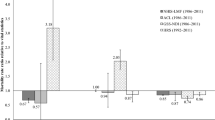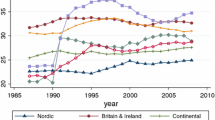Abstract
Using 1973 Current Population Survey data matched to 1973-1978 Social Security mortality records, this study measures the relationship between the income and education of men and their subsequent mortality. The estimated relationships are compared with socioeconomic mortality differentials found by Kitagawa and Hauser in their study of 1960 census-death certificate matched data. The comparison suggests that there has been no improvement in the relative mortality experience of low socioeconomic status men. More generally, the article discusses how Social Security data could be used to monitor, on a continual basis, our progress toward eradicating signficant mortality differentials in the United States.
Similar content being viewed by others
References
Aziz, F., and W. Buckler. 1980. Mortality and the continuous work history sample. Pp. 461–466 in Proceedings of the Section on Survey Research Methods, American Statistical Association. Alexandria, Va.: ASA.
Aziz, F., B. Kilss, and F. Scheuren. 1978. 1973 Current Population Survey-Administrative Record Exact Match File Codebook. Washington, DC: U.S. Government Printing Office.
Caldwell, S., and T. Diamond. 1979. Income differentials in mortality: Preliminary results based on IRS-SSA linked data. In L. DelBene and F. Scheuren (eds.), Statistical Uses of Administrative Records With Emphasis on Mortality and Disability Research. Washington, D.C.: U.S. Government Printing Office.
DelBene, L. 1979. 1937–1976 Social Security Longitudinal Earnings Exact Match File. Washington, DC: U.S. Government Printing Office.
DelBene, L., and F. Aziz. 1982. Further investigation into mortality coverage in Social Security Administration data. In Proceedings of the Section on Survey Research Methods, American Statistical Association. Alexandria, Va.: ASA.
Duleep, H. O. 1986a. Measuring the effect of income on adult mortality. Journal of Human Resources 21:238–251.
—. 1986b. Incorporating longitudinal aspects into mortality research. Journal of Economic and Social Measurement 14:121–133.
Kitagawa, E. M., and P. M. Hauser. 1973. Differential Mortality in the United States: A Study in Socioeconomic Epidemiology. Cambridge, Mass.: Harvard University Press.
Orcutt, G. H., S. Caldwell, and R. Wertheimer II. 1976. Policy Exploration Through Microanalytic Simulation. Washington, D.C.: Urban Institute.
Rosen, S., and P. Taubman. 1979. Changes in the impact of education and income on mortality in the U.S. In L. DelBene and F. Scheuren (eds.), Statistical Uses of Administrative Records With Emphasis on Mortality and Disability Research. Washington, D.C.: U.S. Government Printing Office.
U.S. Bureau of the Census. 1973. Estimates of the Population of the United States by Age, Sex, and Race, April 1, 1960-July 1, 1973. Washington, D.C.: U.S. Government Printing Office.
Author information
Authors and Affiliations
Rights and permissions
About this article
Cite this article
Duleep, H.O. Measuring socioeconomic mortality differentials over time. Demography 26, 345–351 (1989). https://doi.org/10.2307/2061531
Issue Date:
DOI: https://doi.org/10.2307/2061531




